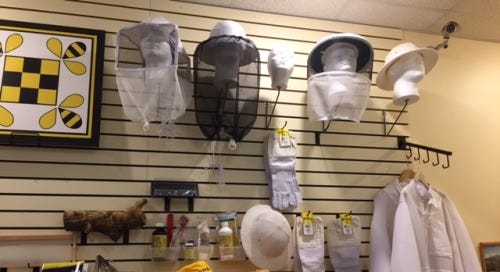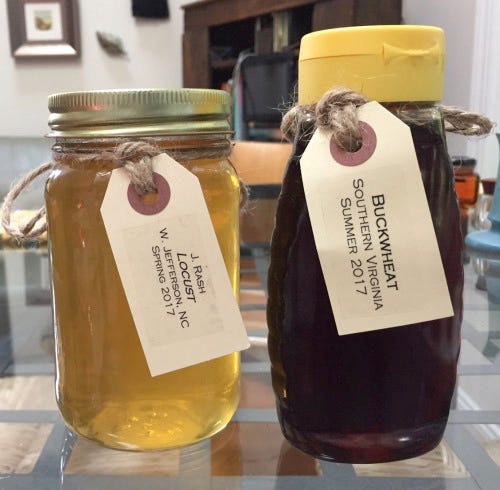Like grapes, apples, olive oils, and oysters, honey is one of those foods that is particularly influenced by terroir–the combination of climate, topography, and soil (or in the case of oysters, ocean) that meld together to create variations in flavor. In the case of honey, however, flower power is also a determining factor.
For example, if rhododendron and azalea blossoms are disproportionately represented among the flowers from which bees gather pollen and nectar, the resulting honey can be toxic to humans. According to the Honey and Pollination Center at the University of California–Davis, there are some 300 flavors of honey available in the United States, which led researchers there to create a “Honey Wheel of Flavors," which begins in the center of the wheel by classifying honeys under very general rubrics–fruity, floral, herbaceous, woody, earthy, spicy, nutty–and further refines the flavors within these categories outward, toward the edges of the wheel. For example, under floral, the honey might carry a dominant note of jasmine, rose, lavender or lilac. Under fruity, the flavor might tend toward tree fruits, dried fruits, or tropical fruits, and further subcategories derive from these. For tree fruits there is apple, orange, pear, cherry, apricot, peach, etc.
Gear at The Honey Hole for beekeeping. Photos by Georgann Eubanks.
Beekeeping is a growing enterprise in pastoral Ashe County, at the northwesternmost corner of North Carolina, where the mountains are round and hillsides are cultivated in Christmas trees. Ashe farmers also raise dairy and beef cattle, apples, trout, and even produce maple syrup.
The Honey Hole of the Blue Ridge on Third Avenue in downtown West Jefferson is run by former Charlotteans Chuck and Shelley Felder, who sell everything a beekeeper could need, along with an alluring variety of honeys produced up and down the East Coast and beyond. It’s a great place to taste test for your favorites.
There’s Blueberry Honey from eastern North Carolina, Red Raspberry from Michigan, separate jars of Alfalfa and Clover Honey from Virginia, two flavors–Eucalyptus and Avocado–from California, and Lavender from France.
While Shelley is the resident bee whisperer (and there is a hive behind glass in the store), Chuck stays busy making honey butters. His “Vanilla Bean Vibrance” is a honey infused with Madagascar vanilla beans and intended to be drizzled over ice cream or pie. He also makes a mean Bourbon Barrel Honey and a fragrant honey soap with corn grits added as an exfoliate.
The Felders buy the local honey they sell from “eight beekeepers with integrity,” as Chuck puts it. They also sell supplies for raising chickens and feeding wild birds. Shelley teaches beekeeping classes–beginning and advanced–at Wilkes Community College on both the Sparta and West Jefferson campuses. On the day I visited she was shining a light on the queen in the store’s hive, explaining to a customer that her Highness was just then having her breakfast and bath, being rolled by the drones while she moved not a wisp of her wings. Lucy, the store’s resident cat, was appropriately disinterested, lurking under a shelf of books on beekeeping.
Opposite ends of the spectrum: Locust and Buckwheat.
I selected two kinds of honey to take home with me, tastes which couldn’t have been more different. The locust honey that Chuck brought out of his secret stash in the back was extremely pale and very rare, he said, because the locust trees around Ashe County only bloom and yield nectar every five to seven years. “This year,” Chuck explained, “the blossoms had the nectar knocked out of them by heavy rains, and though there was still pollen, you’ve got to have both for honey."
At this elevation in the Blue Ridge, the weather can be especially harsh–wet, cold, and full of bluster–and locust blossoms only last for about ten days anyway. However, locust trees bloom early in the spring, so it’s more likely that you’ll get a truly monofloral black locust honey, before the bees are tempted to sup elsewhere. The Ashe County locust honey has a subtle and delicate flavor–a pure sweetness that’s not complex. As I learned, the paler the honey, the more likely it is purely locust, not tinged by nectar from other flowers.
By contrast, the buckwheat honey I purchased in West Jefferson is nearly as dark as molasses. The moment I tasted it, I was transported into my great, great Aunt Annie’s farmhouse, a stick-built cottage in rural Georgia with timber paneling so long ago harvested that it was rock hard and smelled of–well, old wood and old lady.
Later in my research on buckwheat honey, I came across an article entitled "Why Some Honey Tastes Like Cat Pee.” Oh good grief. I have to admit, I get it, but to my palate, having never tasted cat pee, (and yes, my aunt had cats), I think this buckwheat honey simply has a depth beyond other honeys–a taste something like the scent of an old, empty armoire just opened to the light of day after a long time. In fact, the color is not unlike a piece of antique furniture aged to a lovely, molasses patina.
In The Month of Their Ripening: North Carolina Heritage Foods Through the Year (my book, from UNC Press) I write about foods that are ephemeral, those tastes that come only once a season, foods that make us wait for them, long for their taste, and in so doing, we appreciate their amazing distinctions.
Honey is nothing short of a miracle, a gift of nature now seriously endangered by the perils that threaten bees–commercial development of open land, pesticide overuse, and climate shifts. The range of those flavors set out on a glass shelf in West Jefferson was a veritable altar and testament to our Eden now under siege. And ironically, these two delectable flavors I brought home–locust and buckwheat–will grow in the poorest of soils. To bee or not to bee is not a question. Humans and all our food sources would be gone from the planet in three years without our pollinators, Chuck Felder reminded me.






